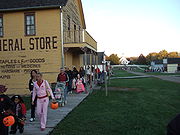
Living History Farms
Encyclopedia

Urbandale, Iowa
Urbandale is a city in Polk and Dallas counties in the U.S. state of Iowa. As of the 2000 census, the city population was 29,072; a special census taken by the city in 2005 counted 35,904 residents and the United States Census Bureau estimated that 38,369 residents lived there in 2008...
. The museum's mission is to educate visitors and demonstrate the past 300 hundred years of Iowa's agricultural history. As its name implies, the museum follows the methodology of living history
Living history
Living history is an activity that incorporates historical tools, activities and dress into an interactive presentation that seeks to give observers and participants a sense of stepping back in time. Although it does not necessarily seek to reenact a specific event in history, living history is...
in depicting the lives of people living on farms in the years of 1700, 1850, and 1900, engaging in various agricultural
Agriculture
Agriculture is the cultivation of animals, plants, fungi and other life forms for food, fiber, and other products used to sustain life. Agriculture was the key implement in the rise of sedentary human civilization, whereby farming of domesticated species created food surpluses that nurtured the...
activities.
Dr. William G. Murray, an agricultural economist from Iowa State University
Iowa State University
Iowa State University of Science and Technology, more commonly known as Iowa State University , is a public land-grant and space-grant research university located in Ames, Iowa, United States. Iowa State has produced astronauts, scientists, and Nobel and Pulitzer Prize winners, along with a host of...
and two-time gubernatorial candidate, founded the organization, which opened to the public in 1970. Dr. Murray's passion was not to have a museum where people viewed things under glass, but rather a place where history was lived.
The museum is divided by Interstate 35/80 and a tractor-drawn cart transports visitors from the town (which is next to the entrance at the Visitor Center) to the west side of the museum. After visiting the 1700 Ioway Farm, 1850 Farm, 1900 Farm, and Wallace Exhibit Center, visitors return to the east side of the interstate. The 1875 town of Walnut Hill features multiple structures, including the Martin and Ellen Flynn Home and barn, both original to the site.
The 1700 Ioway Indian Farm features the farming techniques of the Ioway Indians. The farm includes produce originating from the 1700's including blue corn and Omaha melons. Interpreters inform visitors about the Ioway lifestyle including topics such as hunting, roles of men and women, and tool making. Demonstrations include tanning hide, food preparation, and making traditional pottery.
The 1850 Pioneer Farm includes a log cabin where visitors are able to see how women cooked with cast iron over a fire, as well as tasks done by hand such as wool spinning and candle making. Outside visitors can see an ox driven plow till the fields filled with crops of corn, wheat, and potatoes.
The 1875 Town of Walnut Hill features a general store, schoolhouse, Victorian mansion, bank, and law office among other pioneer town buildings. The town portrays the relationship and dependency between the town's people, the merchants, and the farmers.
The 1900 Horse Powered Farm demonstrates the changes that modern machinery and the Industrial Revolution had on farm life. Handwork was replaced by the use of machinery and work within the farm house changed to include methods such as canning.
The particular type of interpretation employed at Living History Farms is third person
Third-person shooter
Third-person shooter is a genre of 3D action games in which the player character is visible on-screen, and the gameplay consists primarily of shooting.-Definition:...
, so while the people visitors interact with in the museum may be dressed in the manner of the appropriate time period, they do not attempt to "act" as if they are truly the person they are interpreting (accents, etc.). The presenters often perform the work, and thus will say, "I baked this bread," or they address audiences with phrases such as "This is how a Print Shop would look in the year 1875." However, since the presenters do not role play, visitors can ask questions about modern issues and receive direct answers.
Living History Farms was the site of Pope John Paul II
Pope John Paul II
Blessed Pope John Paul II , born Karol Józef Wojtyła , reigned as Pope of the Catholic Church and Sovereign of Vatican City from 16 October 1978 until his death on 2 April 2005, at of age. His was the second-longest documented pontificate, which lasted ; only Pope Pius IX ...
's ecumenical service, mass and homily to an audience of nearly 300,000 on October 4, 1979.

